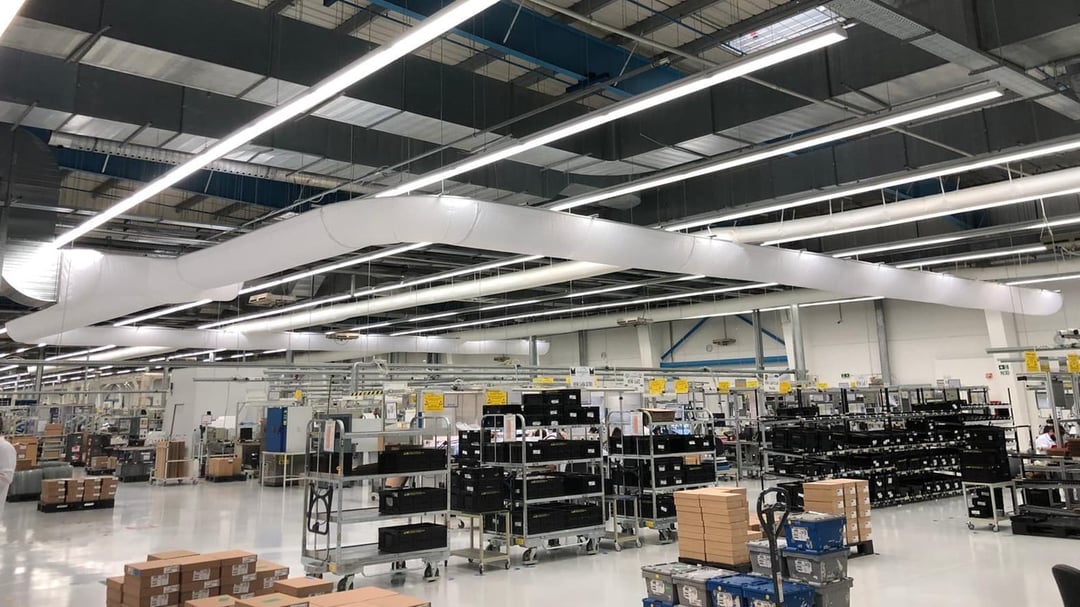
Industrial evaporative cooling
A suitable cooling and ventilation solution for every industry
It is well understood that both employees and machines perform better in a well-balanced working climate. Industrial evaporative cooling provides production facilities with the perfect solution for a comfortable, healthy, and productive environment. Oxycom’s IntrCooll is a two-stage evaporative cooling technology is suitable for all industries, ranging from the metal industry to the food industry.
A healthy, well-ventilated workplace
Some industrial processes release a lot of heat, gases, vapours, and dust. Working in such conditions is harmful to your health and overall well-being. It is, therefore, imperative to have an adequate ventilation system in place. Two-stage evaporative cooling works on the principle of displacement cooling. Fresh air is blown into the production facility and, once circulated, is extracted through an exhaust. The continuous ventilation refreshes the indoor air completely, several times an hour. As a result of the constant ventilation, heat, gases, vapours, dust, harmful substances, and as we are all aware of nowadays - viruses, are extracted from the workplace.
Curious about the options for industrial cooling? Read more in our blog "What types of indoor cooling (AC) options are there for production facilities?"./Case%20studies%20(Pictures)/24%20Tailorsteel/247TailorSteel_Metal_Oxycom.jpg?width=1600&height=1067&name=247TailorSteel_Metal_Oxycom.jpg)
Well-balanced humidity for the graphic, plastic, and packaging industry
Humidity can have a detrimental effect on materials such as paper and plastic, which may raise concerns for the use of evaporative cooling in the graphic and plastic industry. However, a two-stage evaporative cooling system ensures that humidity levels remain low and minimizes the chances of material deformation, as well as static charge and high dust load. Furthermore, two-stage evaporative cooling ensures a well-balanced humidity which prevents condensation on cooled molds, making it an optimal cooling solution for the packaging industry.
Food safety and hygiene ensured with Oxycom’s patented two-stage evaporative cooling
Food safety is the top priority in the food industry. As evaporative cooling uses fresh air to cool, some raise the concern that this evaporative/adiabatic process is unhygienic and could contain all kinds of bacteria and fungi. Not in the least because the air flows through a wetted pad through in the evaporative process - an ideal breeding ground for fungi and bacteria. However, to prevent fungi and bacteria from getting into the airstream that is blown into the production hall, the pads in the two-stage IntrCooll evaporative cooling system are completely dried every 24 hours, resulting in a total bio-shock and killing off everything that has nestled itself in the pad.
Moreover, the IntrCooll uses the patented Oxyvap® pad made of aluminum and coated with an antibacterial silver ion layer which prevents the growth of bacteria and fungi. This allows our systems to be VDI 6022 hygiene certified. Additionally, a UVC water disinfection system can be added to the IntrCooll installation. This way, Oxycom’s two-stage evaporative cooling system ensures optimal hygiene within production facilities and buildings.
/Case%20studies%20(Pictures)/24%20Tailorsteel/SDG-1106%20small.jpg?width=2000&height=1333&name=SDG-1106%20small.jpg)
A stable climate for high precision processes
In all cases, it is desirable to have a steady and consistent temperature in the workplace. However, when working with high precisions parts, maintaining a stable temperature is crucial for the production process. For example, precision metalworking demands stable temperatures at all times as temperature fluctuations have a detrimental effect on the exact tolerances of the workpieces. Two-stage evaporative cooling ensures a stable climate at all times, preferably keeping temperatures close to 20 °C all year.
![247TailorSteel [EN]](https://www.oxy-com.com/hs-fs/hubfs/Case%20studies%20(Pictures,%20PDFs,%20etc.)/Book%20cover%20pictures%20(whitepapers%20and%20case%20studies)/EN/247TailorSteel/247TailorSteel%20%5BEN%5D.png?width=800&name=247TailorSteel%20%5BEN%5D.png)
A comfortable and sustainable working climate with IntrCooll
247TailorSteel saw they had to improve their indoor climate to provide a healthy and productive work environment. With Oxycom’s sustainable cooling and ventilation system, IntrCooll, 247TailorSteel has been able to create a stable and optimal working climate for their employees.
Related articles
See all articles/Case%20studies%20(Pictures)/24%20Tailorsteel/SDG-1106%20small.jpg?width=450&name=SDG-1106%20small.jpg)
Adiabatic cooling & heating for industrial buildings
Adiabatic cooling & heating provide a healthy and comfortable environment while saving up to 90% energy. Read this blog for more information.
/Case%20studies%20(Pictures)/BMI/www.oxy-com.comhubfsKlanten%20casestudiesBMIMetal%20industry%20adiabatic%20cooling.jpg?width=450&name=www.oxy-com.comhubfsKlanten%20casestudiesBMIMetal%20industry%20adiabatic%20cooling.jpg)
Is adiabatic cooling suitable for my production facility?
Indoor environmental conditions in factory buildings are not only affected by outside temperatures but also by the heat that is generated during the manufacturing process.
/Adiabatisch%20koelen%20metaalindustrie.jpeg?width=450&name=Adiabatisch%20koelen%20metaalindustrie.jpeg)
What types of indoor cooling (AC) options are there for production facilities?
This blog illustrates some of the indoor cooling options to provide a healthy and productive climate for your production facilities.
Back to overview:
Evaporative cooling